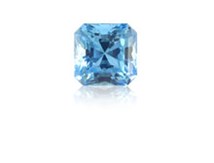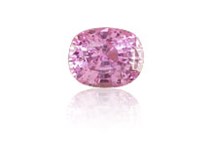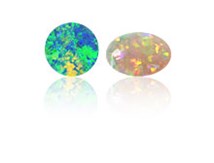A Gemstone Guide
Grouped by color, below is a mix of gemstone poetry, history and romance. A tour of some of the more popular gems we use in jewelry, definitive by no means, but we are sure you will come away having learned about a gem or two.
Precious vs. Semi-Precious: What’s the Difference?
The distinction between precious and semi-precious gems started in the mid 1800’s. Ruby, emerald, sapphire and diamond were deemed “precious” due to their rarity, value, and demand.
The term semi-precious can be quite misleading. You can have a 1 carat tourmaline gemstone that sells for $10,000 while a poor quality 1 carat ruby, emerald or sapphire may only be worth $50.
Price and a gems preciousness is determined by rarity and beauty, not whether it’s an emerald or a spinel.
Sapphire

The color blue holds an endless fascination. From the high dome of the sky to the oceans that cover two-thirds of the globe’s surface, blue literally surrounds us. Seen from space, Earth is revealed as a shimmering blue planet. It’s little wonder, then, that the breathtaking blue of Sapphire has captured one’s imagination from the beginning. Ranging from the deepest midnight to brilliant cornflower blue, Sapphires have long been prized for their intense, velvety color.
The ancients believed that Blue Sapphire – holding in its depths the power of the sea and sky – had influence over the spirit world as well; among its reputed powers was the ability to make peace between warring parties. The calming influence of blue has also made it an enduring symbol for loyalty and trust – one reason that women around the world choose Sapphire for their engagement rings.
Flattering to all skin tones, blue is truly a color for all seasons.
Aquamarine

Imagine a dip in a crystal blue mountain lake – the morning air crisp and expectant, the sky soaring high and cloudless overhead. This is the unique refreshment of Aquamarine.
The name means “ocean water”, and tales of Aquamarine date back to ancient seafaring days. Sailors of old believed that these glittering gems came from the treasure chests of mermaids. Perhaps it’s no wonder that Aquamarine is said to bring good luck to all who sail the seas.
One of the most popular of all gems Aquamarine ranges in color from intense deep blue to lighter shades of sky and water.
Hardness 7.5-8 Aquamarine is rated “good” for everyday wear
Blue Topaz

From the pure pastel blue of an Alpine glacier…to the glow of the mid-summer sky…to the aquatic hue of the deepest ocean, refreshing Blue Topaz brings a breath of fresh air to contemporary jewelry designs.
The ancients prized Topaz as a stone of divine majesty. It was believed to dispel enchantments, detect poisons – even render the wearer invisible at will.
Hardness 8 Topaz is rated “Good” for everyday wear
Tanzanite

The first thing you notice is the color: Deep, vivid blue, with a purplish tinge that dances about the stone as it moves in the light. With its dazzling intensity and complex play of color, Tanzanite boasts a uniquely sensuous appeal.
Tanzanite’s rarity and exotic origin are also part of its fascination. For this modern gemstone was unknown until 1967, when Massai herdsmen in eastern Africa noticed blue crystals sparkling in the sun. Tanzanite’s dramatic discovery, couples with its scintillating beauty, caused a worldwide sensation. To date the world’s only source for the gem remains the hills of northern Tanzania, near Mount Kilimanjaro.
Tanzanite’s dual color – brilliant blue with hints of purple – makes it both warm and cool. Bold yet meltingly beautiful, it is a favorite of many gem lovers.
Hardness 6-7 Tanzanite is not for everyday wear and one should take care when wearing.
Amethyst

Purple passion. From refreshing lilac to ripe plum, the drama and excitement of purple are fully reflected in Amethyst.
Perhaps because of its depth and richness, Amethyst has always been associated with intense emotion. It is fitting, then, that the legend of its origin is a tale of revenge, devotion, and immortal remorse.
The story is told that Dionysus, the Greek god of wine, was insulted one day by a mortal. Enraged he called forth vicious tigers to exact revenge on the next mortal to cross his path. This individual was unfortunately, the maiden Amethyst. On her way to pay tribute to the Goddess Diana, the innocent girl suddenly found herself face to face with the tigers of the vengeful God. To save her from the beasts, Diana turned Amethyst into a statue of pure crystalline quartz. So beautiful was the maiden that Dionysus, in sorrow and remorse, wept tears of rich wine over the statue. His tears stained the quartz, thus creating the poetic gem which still bears her name. Amethyst ranges in color from deep purple to pale lavender.
Hardness 7 Amethyst is rated “good” for everyday wear.
Pink Tourmaline

No one, it’s been said, can resist a woman wearing pink. This enthralling, positive hue not only enhances the energy of its wearer, but also attracts the attention and energy of others.
Bold, confident, at once beautifully sensitive and self-assured: exhilarating Pink Tourmaline expresses timeless feminine charm with a decidedly modern edge. Its many hues ranging from bubblegum pink to rich crimson, complement all skin tones and offer year-round fashion appeal.
Hardness 7-7.5 Tourmaline is rated “Good” for everyday wear
Pink Sapphire

From the soft embrace of pastel pink to the intensely passionate hot pink, no other color has the power to render men weak in the knees as a woman wearing pink. The luster and brilliance of Pink Sapphire speaks to a woman’s desire to feel glamorous and feminine.
Hardness 9 Sapphire is rated “excellent” for everyday wear
Ruby
Blood-red. Fire-red. Color that burns along veins, and gives brightness to the night. If you are looking for the color of life itself, look no further than red. And the gemstone that brings red to vivid life can only have one name: Ruby.
The “king of gems,” Ruby is one of the world’s oldest and most revered gemstones. It is also one of the rarest. Rubies with hardly any inclusions are so rare that large stones of good color fetch higher prices at auction than even diamonds.
Fiery and romantic, showing brilliant depth and intensity, the red hue of Ruby is certain to draw attention. In settings that focus attention on voluptuous color, Ruby sends a message of drop-dead glamour. Geometric-inspired jewelry designs featuring Ruby are equally appealing to both men and women who seek to convey strength, honor and classic style.
Hardness 9 Ruby is rated “excellent” for everyday wear.
Garnet

When one thinks of Garnet it is often the glowing deep red with hints of orange and brown – the colors of Autumn Harvest or Indian Summer that comes to mind. Wrapped in its warmth, we feel protected. It’s no wonder that Garnet was once believed to have healing properties, particularly in diseases related to the blood.
Tales of Garnet date back to the time of Noah, who is said to have steered the ark by a lantern made of this dazzling gem. Garnet jewels were also favored in ancient Rome and Egypt, where they were held to ward off evil. The astonishing brilliance of Garnet, now understood to result from its high refraction of light, may explain the stone’s legendary reputation for magically illuminating the night.
Garnet occurs in shades of red, green, orange, and yellow.
Citrine

The mellow gold of citrine draws us in and brightens our moods. A golden quartz whose name comes from the French word for “lemon”, Citrine brings the energizing refreshment of an icy summer drink.
Sunny and full of light, this sparkling gem was once thought to protect the wearer against various evils – from snake venom to wicked thoughts. Today, its radiant color is associated with cheerfulness, youth and vitality. Citrine ranges from slightly golden yellow to a medium gold showing hints of orange.
Hardness 7 Citrine is rated “good” for everyday wear
Yellow Topaz

The color of certain gems can be, quite literally, intoxicating. From the pale amber gold of old cognac to the warmly glowing browns of aged whiskey, Yellow Topaz invites us to drink in its beauty. Its warm golden hues, bring a youthful blush of color to those who wear it.
Topaz was revered by the Egyptians and Romans, who associated it with the setting sun. In modern times, rich stores of Precious Topaz were discovered in Russia; placed in the jewels of Russian Czarinas’s, the gem earned the name “Imperial Topaz”.
The mesmerizing hue of Yellow Topaz is symbolic of love and affection. And so remarkable is the gemstone’s transparency and brilliance that famous examples have been confused with diamonds.
Hardness 8 Topaz is rated “Good” for everyday wear
Green Tourmaline

The color of growth and fertility, green is naturally linked to hope, strength, and physical health. Vivid Green Tourmaline, ranging from pure green to more complex shades touched with yellow or blue, makes the most of green’s positive associations. Legend tells of tourmaline’s power to attract friends and lovers, protect the wearer against bad decisions, and shield its owner from danger.
Hardness 7-7.5 Tourmaline is rated “Good” for everyday wear.
Emerald

Lush. Exotic. Untamed. This is no polite, garden-variety green: Emerald pulses with life and vitality. In its depths beats the heart of the rain forest, its shadows alive with promise, expectation…even danger.
More valuable than even diamonds, fine quality Emeralds of significant size are among the world’s most bewitching jewels. Their incomparable green color is produced only under extremely rare conditions. Because these conditions also result in tiny cracks and cavities in the stone, inclusions are allowed in top quality Emeralds.
Ancient history records Emerald mines near the Red Sea. Known as “Cleopatra’s Mines,” the Egyptian Pharaohs gathered gems there between 3000 and 1500 B.C. The Incas and Aztec of South America once worshiped Emerald as a holy stone. And Maharajas of India, who believed the gem brought luck and restored health, had multitudes of Emeralds in their treasure vaults. The hue of nature itself, Emerald enjoys appeal year-around: an ideal accent for Spring wardrobes, a highlight of Summer designs, an Autumn complement, and the perfect hue to dispel Winter.
Hardness 7.5-8 Emerald is rated “fair to good” for everyday wear.
Tsavorite Garnet
 Rich and intense, boasting very high brilliance, Tsavorite is a refreshing surprise of sparkling verdant color. Its tones range from a light spring green to a deep, breathtaking shade of forest green, making it one of the few gems to rival Emerald in color and beauty.
Rich and intense, boasting very high brilliance, Tsavorite is a refreshing surprise of sparkling verdant color. Its tones range from a light spring green to a deep, breathtaking shade of forest green, making it one of the few gems to rival Emerald in color and beauty.
Tsavorite was discovered near the Tsavo National Park in the Northeastern part of Tanzania. Worldwide recognition of the gem came in 1974, when Tiffany & Co. began promoting its magnificent color, depth and transparency. Rough Tsavorite crystals weighing over five carats are found only occasionally, making cut stones over two carats both rare and valuable.
Hardness 7-7.5 Garnet is rated “good” for everyday wear.
Peridot

The green-apple crispness of Peridot is a perfect compliment to today’s lively fashion scene. As the popularity of green continues to grow, so does the youthful appeal of this citrus-hued gem.
Peridot is treasured by the Hawaiian peoples who believed the gem to be the tears of the Goddess Pele. Peridot was known in the ancient world as well, Romans named the gem “Evening Emerald” as its brilliant color did not fade in the lamplight, but instead seemed to glow in the evening hours. Partly for this reason, Peridot was believed to help dreams become reality and to drive away the evil spirits of night.
Peridot’s freshness invigorates and delights the senses. Intense and dazzling, its juicy color finds appeal across generations.
Hardness 6.5-7 Peridot is rated “fair” for everyday wear
Opal

With its pulsating display of fire and color, Opal was long thought to hold magical powers. For this reason, rare Opals were often reserved for royalty. The crown of the Holy Roman Emperor held a superb example of a fiery red Opal called “The Burning of Troy.” This was given as a gift from Napoleon to Josephine – forming part of the crown jewels of France. Queen Victoria also loved Opals, and often presented them as wedding gifts.
The changeable color and flashing fire seen in Opal are symbolic of love, life, hope and truth. Its rainbow of color makes Opal an ideal fashion accessory with year-round appeal.
For a century Australia was the primary source for the worlds opals. A significant has recently occurred in East Africa opening up a new world of patters and colors to enjoy.
Hardness 5-6.5 is not for everyday wear and one should take care when wearing.
Pearls

Pearls have been an object of desire from the first days of human society. Throughout Asia and the Mediterranean, Pearls were treasured not only for their rare beauty but as symbols of harmony, purity, and wisdom. Down through the centuries, man’s desire for the perfection of Pearls has not waned. The exotic, lustrous skin of Pearls, smooth and silky to the hand and eye, embodies all that is feminine.
The overtones of the average Pearl range from pale cream to pinkish white, champagne and silver grey. These overtone hues, when properly matched to the complexion of their owner, are what make Pearl jewelry a unique statement of perfection and grace.
No other jewel makes the transition of day to evening as smoothly as Pearls. In addition to the classic strands and stud earrings, creative new designs are helping to bring these alluring gems to the forefront of the fashion world. Either by themselves or paired with other colored gems, lustrous Pearls offer glamorous sophistication and timeless elegance.
White Cultured Pearls:
Akoya
Born from an oyster, Akoya Pearls are what people typically imagine when thinking of a pearl. Made famous by Kokichi Mikimoto, who helped perfect modern-day pearl culturing techniques, Akoya Cultured Pearls grow between 2 and 9mm. They are primarily farmed in salt water through central and southern Japan and along the coast of China.
Freshwater
Although originally from Japan, 90% of the world’s freshwater pearls now come from China. Most are irregularly shaped. With improved farming techniques, however, China now produces round white pearls in sizes up to 9.5mm.
Tahitian Pearl

Tahitian Cultured Pearls, often called “Black Pearls” are found in the turquoise-colored lagoons of French Polynesia in the South Seas.
Tahitian Cultured Pearls are born from the black-lipped oyster. These giant tropical mollusks can live for 30 years in the wild, can weigh up to 11 pounds and can grow to reach a foot in diameter. In the 19th century, free-diving Polynesians braved sharks, depths of up to 130 feet, and the bends to harvest the valuable mollusk. Although only one in 15,000 oysters produced a natural pearl, the inner shell was so popular with the European button industry that the resource was eventually devastated.
Today, a complex cultivation process has resurrected the pearl industry in French Polynesia. The French Polynesian Government has strict regulations on pearl production which assures quality and value.
The grace and elegance of Tahitian Cultured Pearls stand as one of nature’s most amazing creations.
Hardness 2.5-4 Pearls require special care. Please read our Wear Care Guide on Pearls.



